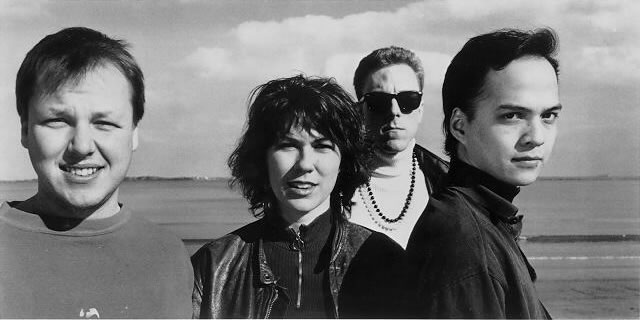Where Buzz Aldrin has god-like status!

09/28/2017
Updated on 10/03/2019

(Editor’s Note: Kim Shattuck died on October 2, 2019. You can read more about her unfortunate passing here.)
When the Pixies1 reunited in 2004, it was a huge prayer answered for many devoted fans. Having previously been disbanded in 1992 by frontman Black Francis, a.k.a. Frank Black—real name Charles Thompson (which is what we’ll call him for the rest of this piece)—the odds of the post-punk band ever playing again seemed slim at best. There were stories of acrimony, personality clashes, and creative differences between the members, all of which was standard band-breaking-up stuff, but this breakup felt colder and deeper than most. No public feuds. No tell-all books or articles. Just a very business-like split. But then, like other things in business, time and money-making potential heal most wounds.
After reuniting, the Pixies first released a new single. Then after several months of rehearsal, they went on tour playing at sold-out venues to fanatic audiences filled with both young and the middle-aged devotees, all of whom would sing along lustfully to the band’s loud and echoing choruses. True, the Pixies were 12 years removed from the glory days, aside from a few extra pounds and some minor wrinkles, they looked and sounded the pretty much same. Best of all, they were enjoying themselves. Joey Santiago’s wailing lead guitar was as crisp and haunting as ever. Thompson’s yell-voice was just as shrill and desperate as it was in the TT the Bear’s days in Cambridge, MA. Drummer David Lovering came back with new-found energy and zeal pounding away at his skins like a kid who rediscovered a favorite old toy. And then there was bass player Kim Deal…
Ahhhh Kim Deal. Her sandy voice, her warm smile, the bright and chipper way she would say, “Thanks!” after a round of applause from the crowd—Deal brought not only her bass talents and singing voice but her warm personality and stage presence. Both musically and in her demeanor, she was the perfect counterweight to Thompson, who could sometimes seem too much in his own head and removed. Thompson once remarked, “I see Kim [Deal] as our secret weapon. She’s like, ‘Hi.’ And the crowd goes crazy. Or ‘Gee, it’s hot.’ And they just lose it. I don’t even talk onstage anymore.”
Things continued to go well for the Pixies over the next 9 years. They did a couple more tours, released a greatest hits album, and made a ton of money. But despite their success, the musicians were not content with being just a “nostalgic act”. They wanted to play some new material. So the Pixies collectively decided it was time to record a new full-length album, their first since the 1991 collection, Trompe le Monde.

Here’s an early photo of the Pixies. From left to right: Black Francis (Thompson), Kim Deal, David Lovering, Joey Santiago.
The Pixies were in Wales, UK, in 2013 recording new songs for what would eventually be their album Indie Cindy, when Deal told her bandmates that she was quitting. It came as a huge surprise. According to Lovering in this interview in 2016, Thompson, Lovering, and Santiago were extremely upset and sad about Deal’s decision, and they tried in earnest to convince her to change her mind, but they couldn’t get her to budge. The next day Deal was on a plane heading back to the U.S.
Why she left is still a bit unclear, and trying to get any of them to give a reason for her leaving is a fool’s errand, at least to people who’ve followed the band since their early days. Deal, Lovering, Santiago, and Thompson may have very strong, very different, and fiercely independent personalities, but when it comes to interviews and media relations, they all shut right up when asked about about the band’s emotional inner workings.
If we were to speculate as to why she left, we could go back to the band’s initial breakup in 1992. It was Thompson, as de facto band leader, who broke up the Pixies after several years of difficulty. There had been tensions between Deal and Thompson, mostly creative differences, and definite personality conflicts. For the most part they got along well on the surface, but Deal wanted to have more songs on their albums and more say in the creative direction of the band. Thompson saw himself as the main force in the Pixies and may have been less than accommodating to Deal.

Kim Deal on stage with the Pixies in 2010. (Photo by Alejandro Jofré)
What is also true is that the Pixies had spent their previous six years releasing albums and touring the world. Maybe it was the fatigue. Maybe Thompson got tired of Deal. Maybe everybody was just tired of each other. The fact is they were burnt out on each other. There was even some discussion of there being sexual tension between Thompson and Deal that added to this already bitter stew of jealousy and fatigue.
(Editor’s note: Not sure how much stock I’d put into the “sexual tension” thing. You can check out this article in Spin where it’s mentioned, but for the most part it seems like speculative bullshit due to little more than Thompson being a boy and Deal being a girl and a bunch of Boston-area musicians who liked to gossip.)
Whatever their problems, when the Pixies reunited in 2004, it wasn’t as if the tensions just magically went away. Perhaps they were each in a better place to deal with them and were only too happy to be playing Pixies music together again to notice what divided them in the first place.
Perhaps more likely than anything, the novelty of being in the Pixies again was gone for Deal and she wanted out.
Deal leaving was a tough loss. Any of them leaving would have been difficult for sure, but Deal was a distinctive part of the Pixies. In many ways, the biggest difference between the Pixies and one of Thompson’s other/solo acts was Deal’s presence. Not to diminish Lovering’s and Santiago’s presence and contributions — they were indeed a huge part of what made the Pixies the Pixies — but Deal was special.
After a lot of consideration, Lovering, Thompson, and Santiago decided to finish their album and just keep going. And really, why not? They were having too much fun playing in a band together again, and they were making too much money to just walk away. So they went out and got themselves a new bass player—a woman, because as Thompson always said, a female voice is a fundamental part of the Pixies sound. In their choice, they made a very intriguing move and brought in the talented and experienced Kim Shattuck.
Shattuck was big name in musical circles to throw into the mix. She had cut her indie-punk teeth in the late 80s

The Pixies in 2013 with Kim Shattuck.
and 90s as a singer, bass player, and guitarist. A very well-known and well-liked musician who brought with her ability, presence, and pedigree, Shattuck first gained notice when she began playing with The Pandoras in 1985. Looking to go in a different musical direction, Shattuck left them and formed The Muffs in 1991, where she saw her biggest success. As a singer/songwriter and guitarist with the Muffs, she came to epitomize a type of west-coast 90s indie-punk in both style and sound. She also penned some super catchy tunes.
The new bassist had not only the background and the ability, she also had charisma. Shattuck smiled a lot, showed enthusiasm, interacted with the audience, and generally looked like she was having fun playing. This was a similar element that Deal added during her tenure as the bass player—a bright smile that acknowledged the loving crowd in a way that the other three musicians couldn’t. So on paper, Shattuck looked like a good fit, but really she was different from the others and different from Deal.
Shattuck had more of a sense of style than the rest of the Pixies. She had a jagged haircut, shoulder-length at the sides, chopped at the back, bangs in the front, dye applied wherever. She wore a lot of short skirts and thigh-highs, although not in a risqué sort of way, but more in an aged hipster kind of way. This is in contrast to the rest of the group who wore khakis or jeans, and button-down shirts—kinda like suburban guys on the weekend. Deal herself often dressed like she was getting ready to clean her bathroom rather than play bass. In all the Pixies looked plain, whereas Shattuck did not.
On stage, Shattuck moved to the beat more than the other members. Though not necessarily dancing or doing karate kicks, she would do a bit of head bobbing, pogo jumping, and swaying. She had a more dynamic presence. She was also a bit more interactive and outwardly enthusiastic, and would feed off the audiences they played in front of, whereas the rest of the Pixies seemed less connected. In general, Shattuck was a much sunnier person than the others.
Differences aside, Shattuck’s voice was not at all out-of-place. Abandoning some of the hard-throated tones that she used with the Muffs, Shattuck provided complementary backing vocals and strong harmonies for Thompson. Fans even came around to her quicker than most people would’ve thought. According to Shattuck, people during concerts would cheer her on yelling, “We love you, new Kim!”
Indeed things went well with the Pixies new lineup.
In November 2013, after only four months touring with the band, Shattuck got a call from the Pixies’ manager. This call by the way came the day after she said goodbye to the other band members at the airport at the conclusion of the tour. The manager told her she was fired, or rather “let go”, which as everyone knows is passive aggressive-speak for “fired”. The manager said that the band was going with another bass player.
No explanation as to why. No word from the actual band members. Shattuck was just out.
WT effin’ F!?

Kim Shattuck with her band, The Muffs. Ronnie Barnett, the Muffs’ bassist, is on the left in the background.
The suddenness and impersonal coldness with which the news was delivered came as a complete shock to Shattuck. In this interview with the Phoenix New Times, Shattuck gave the following description of how the firing went down:
When he “let me go,” he told me that the band picked someone else. I asked questions and got answers that didn’t really explain anything, like, “Did I suck?” “No, you didn’t suck.” “Did I let anybody down?” “No, you didn’t let anybody down,” And then the reason nobody talked to me after that was because I announced it — I announced that I was disappointed that I wasn’t going to be in the band anymore.
The announcement Shattuck mentioned was the following post she made on Facebook and Twitter:
“Super disappointed to learn that my time with the Pixies ended today. Amazing experience. Looking forward to focusing my attention back on the Muffs and our upcoming new album. All the best to everyone.”
There’s nothing in that post that should have really gotten her in trouble, but apparently the Pixies weren’t too keen on her announcing it for one reason or another. Santiago in this interview halfway attempted to put the incident into perspective, but in typical Pixies fashion, he gave a very rambling and vague response with hints of defensiveness. In his roundabout way, he said that the band didn’t think Shattuck was a good fit, and they definitely did not like the fact that she simply announced her being fired without allowing them to do it first. Basically, it was a PR thing.
To understand this firing and how it was done, one need only look at the band’s history and the personalities involved. They were always terrible communicators. This isn’t just outside observation, Joey Santiago has said as much. If you can’t take his word for it, consider the fact that when Thompson broke up the band in 1992, it was by fax. That’s right, Thompson opted to fax his fellow Pixies bandmates instead of calling them up or telling them face-to-face. By any standard, that was pretty cold. Thompson once said that the reason he did it via fax was that there was no email back then and it may not have been best to call everyone individually. The problem with that reasoning was that neither Deal, Lovering, nor Santiago owned faxes. And even in the dark days of faxes, that would’ve been a big no no. (Thompson has since apologized for the fax.)
Like Deal, Santiago, and Lovering when they got the infamous fax from Thompson, Shattuck was shocked, confused, and angry.
When trying to come up with a reason as to why she was fired, Shattuck offered:
“I get the feeling they’re more introverted people than I am. Nobody really talked about deep issues, at least out loud. There was a show at the Mayan in Los Angeles where I got overly enthusiastic and jumped into the crowd, and I know they weren’t thrilled about that. When I got offstage the manager told me not to do that again. I said, ‘Really, for my own safety?’ And he said, ‘No, because the Pixies don’t do that.‘”

The Pixies in 2016 with their new permanent bassist, Paz Lenchantin (second from left in case you couldn’t tell). The way Thompson, Santiago, and Lovering tell the story, they wanted Lenchantin all along.
That incident was probably a single brick in a bigger wall. According to this article in the Guardian, Thompson said that Shattuck’s firing was not based solely on the stage-dive but that there were some definite personality conflicts and some issues with her actual bass playing. Those issues were possibly voiced by Lovering who may have felt that Shattuck wasn’t a decent enough bass player to be there permanently. That could very well be true, but it sort of flies in the face of their recent history. According to Shattuck, she had been secretly practicing with the Pixies for about 6 months before they issued a press release announcing her hiring.
For his part, Thompson when asked about Shattuck’s firing, his response was, in not so many words, that the Pixies don’t really need to explain why the Pixies do what they do. They’re a band. Bands change.
What is unique about being in professional creative bands, if one were to view them more as workplaces rather than as romanticized collectives, is that aside from the usual workplace relationships and tensions, successful bands have fans who feel a certain devotion to the members. They demand answers. But Thompson has always been a professional, and always viewed the Pixies as a business, a job. Putting a period on the incident, Thompson said, “There’s been a shift in the lineup, big woop-dee-doo…as far as we’re concerned it ain’t that big of a deal.”
Reading between the lines, it’s pretty clear that Lovering, Santiago, and Thompson simply realized that they didn’t like Shattuck. It becomes especially apparent when you read their quotes about their current bass player Paz Lenchantin3. They describe her as funny, and brilliant, and as an incredible musician—all things they never said publicly about Shattuck.
Situations become complicated over time with any group of people working together in as close proximity as a band. It’s especially bad when the very people in that group are such poor communicators, introverted, and averse to confrontation. As for Lenchentin, she definitely knows what’s up. She’s been around enough to understand band dynamics and how creative types interact. Lenchentin also understands how personal things can get, which is why she has also said that she was glad that she didn’t come in right after Deal like Shattuck did. In an interview she did for Pitchfork, Lenchentin compared what the Pixies went through with Deal and Shattuck to a romantic relationship.
“I don’t know what happened exactly, but in a way, it’s like they were dating. It’s like, you’re giving it the chance. And then you realize, ‘Oh, something’s not really right.’ So instead of coming in after Kim Deal, it was after a dating period, or maybe a rebound. You don’t want to go right after they’ve been together with someone—‘Is this kind of a rebound, what is this?’”
 Whoop dee doo!
Whoop dee doo!Kim Shattuck is and deserves to be known as more than “the one the Pixies fired” or the “Pixies’ rebound relationship”. Her time with the Pixies was really a brief interlude. Before she started playing with them, Shattuck had just finished recording a new album with the Muffs, and was in the midst of mixing it when the Pixies called. When her time with the Pixies was over, Shattuck finished her work on the album and released it in 2014.
Woop dee doo was, not-so-coincidentally, the name of the Muffs’ new album. The first Muffs album to come out in 10 years, it has been given generally favorable reviews by many of the same critics who had been harshly critical of both of the Pixies’ post-reunion albums4. That’s not to say that there’s a competition between the bands, but it’s important to note the critical success of Shattuck’s work for context. Her time spent as the second bass player for the Pixies was only a footnote in an otherwise successful and notable career.
For some of the Muffs better tracks from their past and current album, have a listen at this not-so-new thing, this old thing, this other old thing, and this not-so-new thing.